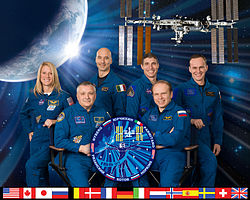Expedition 37
| Expedition 37 | |||
 | |||
| Uppdragsstatistik | |||
|---|---|---|---|
| Rymdstation: | ISS | ||
| Start: | 10 september 2013[1] | ||
| Slut: | 10 november 2013[1] | ||
| Antal besättningsmedlemmar: | 6 st | ||
| Rymdpromenad | |||
| Antal rymdpromenader: | 1st | ||
| Total tid: | 5 timmar, 50 minuter | ||
| Transport | |||
| Uppskjutning: | med Sojuz TMA-08M, Sojuz TMA-09M | ||
| Uppskjutningsplats: | Kosmodromen i Bajkonur | ||
| Landning: | med Sojuz TMA-08M, Sojuz TMA-09M | ||
| Landningsplats: | Kazakstan | ||
| Kronologi | |||
| |||

Expedition 37 var den 37:e expeditionen till Internationella rymdstationen (ISS). Expeditionen började den 10 september 2013 då delar av Expedition 36s besättning återvände till jorden med Sojuz TMA-08M.
Oleg Kotov, Sergej Rjazanskij och Michael S. Hopkins anlände till stationen med Sojuz TMA-10M den 26 september 2013.
Expeditionen avslutades den 10 november 2013 då Karen L. Nyberg, Fjodor Jurtjichin och Luca Parmitano återvände till jorden med Sojuz TMA-09M.
Besättning
| Position | Första delen (10 - 26 september 2013) | Andra delen (26 september - 10 november 2013) |
|---|---|---|
| Befälhavare | Hans fjärde rymdfärd | |
| Flygingenjör 1 | Hennes andra rymdfärd | |
| Flygingenjör 2 | Hans första rymdfärd | |
| Flygingenjör 3 | Hans tredje rymdfärd | |
| Flygingenjör 4 | Hans första rymdfärd | |
| Flygingenjör 5 | Hans första rymdfärd | |
Referenser
- ^ [a b] NASA's Space Station Expedition 37 Arkiverad 4 september 2019 hämtat från the Wayback Machine., läst 3 september 2016.
Externa länkar
| |||||||||||||||||||
Media som används på denna webbplats
ISS Expedition 38 Patch
As the International Space Station (ISS) has become a stepping stone to future space exploration, the Expedition 38 mission patch design paints a visual roadmap of exploration beyond low Earth orbit, most prominently represented by the design's flowing Expedition 38 mission numbers that wrap around Earth, the moon and Mars. Just as the sun is a guiding light in the galaxy, the ISS illuminates the bottom of the design as it is a shining beacon of the advancement of science, knowledge, and technology carried out aboard the Space Station. To visually capture the idea of the ISS being a foundation for infinite discovery, the space station's iconic solar arrays span upwards, providing the number 38 and its exploration roadmap a symbolic pedestal to rest on. Finally, the overall use of red, white, and blue in the design acknowledges the flags of the countries of origin for Expedition 38's crew -- the United States, Russia, and Japan.
Expedition 37 crew members take a break from training at NASA's Johnson Space Center to pose for a crew portrait. Pictured on the front row are Russian cosmonauts Fyodor Yurchikhin (left), commander; and Oleg Kotov, flight engineer. Pictured from the left (back row) are NASA astronaut Karen Nyberg, European Space Agency astronaut Luca Parmitano, NASA astronaut Michael Hopkins and Russian cosmonaut Sergey Ryazanskiy, all flight engineers.
The dynamic design of the Expedition 36 patch portrays the International Space Station's (ISS) iconic solar arrays. The slanted angles denote a kinetic energy leading from the Earth in the lower right to the upper left tip of the triangular shape of the patch, representing the infinite scientific research, education, and long-duration spaceflight capabilities the ISS provides with each mission, as well as our goal for future exploration beyond the Space Station. The numbers 3 and 6 harmoniously intertwine to form expedition number 36 and its gray coloration signifies the unity and neutrality among all of the international partners of the ISS. The blue and gold color scheme of the patch represents the subtle way the central gold orbit wraps around the number 36 to form a trident at its lower right tip. The trident also symbolizes the sea, air, and land, all of which make up the Earth from where the trident originates in the design.
Leonardo da Vinci's Vitruvian Man, created some 525 years ago, as a blend of art and science and a symbol of the medical profession, is depicted amongst the orbits of a variety of satellites circling the Earth at great speed. Da Vinci's drawing, based on the proportions of man as described by the Roman architect Vitruvius, is often used as a symbol of symmetry of the human body and the universe as a whole. Almost perfect in symmetry as well, the International Space Station, with its solar wings spread out and illuminated by the first rays of dawn, is pictured as a mighty beacon arcing upwards across our night skies, the ultimate symbol of science and technology of our age. Six stars represent the six members of Expedition 37 crew, which includes two cosmonauts with a medical background, as well as a native of Da Vinci's Italy.






